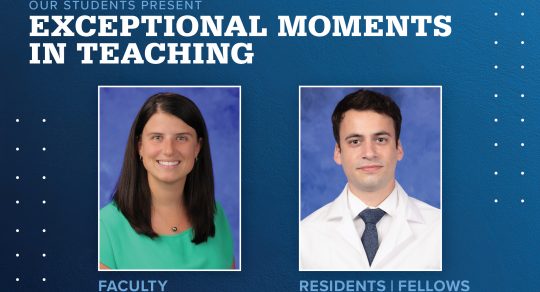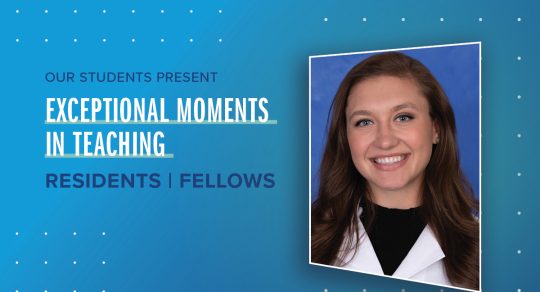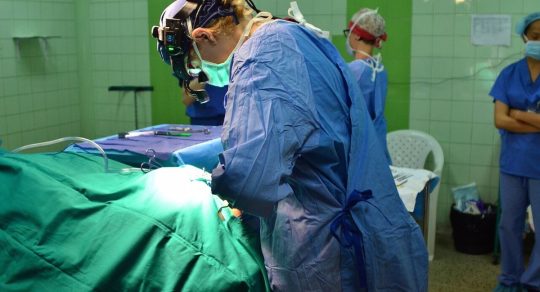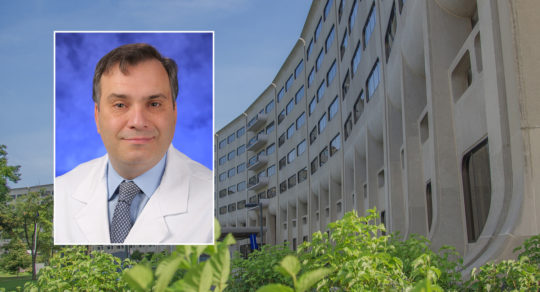Residency
Plastic Surgery Residency
The Plastic Surgery Residency at Penn State Health Milton S. Hershey Medical Center is an integrated six-year, ACGME-accredited program that admits two residents per year.
On This Page
The Plastic Surgery Residency is led by Dr. T. Shane Johnson, chief of the Division of Plastic Surgery, and Dr. John Ingraham, residency program director.
The faculty consists of nine full-time staff surgeons based at Penn State Health Milton S. Hershey Medical Center and three private-practice plastic surgeons in Harrisburg. Hershey Medical Center, founded in 1963, is a Level 1 adult and pediatric trauma center with more than 650 physicians and more than 550 beds. Penn State Children’s Hospital opened on the same campus in 2013.
There are many subspecialty clinics with resident involvement in hand surgery, skin oncology, cosmetic surgery, craniofacial surgery, cleft lip and palate surgery and vascular anomalies. Many of these clinics are multidisciplinary with other specialists at Penn State Health. The craniofacial and cleft teams hold clinic at the Lancaster Cleft Palate Clinic, which is the oldest freestanding multidisciplinary cleft clinic in the world.

Program Overview
Resident education is highly valued at Penn State. The residents collaborate with the staff in structuring the various conferences to provide a broad-based didactic experience that includes:
Combined hand conference with Orthopaedics
Didactic conference incorporating the Plastic Surgery Education Network
Picture rounds
Surgical indications conference
Resident small group/in-service preparation conference
Morbidity and mortality conference
Research conference
Journal club
As a division, Plastic Surgery provides suture skills clinics for all third-year medical students. A yearly microvascular lab is conducted in the by the staff for all residents. Residents also get dedicated microvascular instruction time throughout the year commensurate to their experience and skill level. Anatomic dissection courses on cadavers are performed throughout the year and focus on flap elevation and surgical technique.Academic production is a mandatory component of the plastic surgery residency, with expectations of publications and presentations at academic plastic surgery meetings. The division has NIH-funded projects at Penn State Cancer Institute, as well as the Irvin S. Zubar Plastic Surgery Laboratory run by Dr. Dino Ravnic, which has multiple ongoing basic science and clinical studies. Residents are active in research throughout their training and are encouraged to collaborate with staff that share their academic interests.
Learn More about the Residency
The Plastic Surgery Residency uses The Plastic Surgery Central Application (PSCA) for recruitment and matching. The program will be interviewing in-person.
Completed applications are reviewed and decisions are then made regarding the interview process.
This program usually receives around 300 completed applications, of which 32 applicants are granted interviews for the two categorical positions.
There are two interview dates, conducted in December and January.
The interview process consists of six formal interviews: five with faculty members and one with the chief residents. Between interviews, the applicant has the opportunity to interact with residents at various levels of the training in order to obtain the most accurate information about the quality and disposition of the residency.
The Plastic Surgery Residency would like to know what is happening with graduates. Many have been out of contact. Graduates are asked to email Sarah Sipe at swallace4@pennstatehealth.psu.edu with anything they would like to share.
Evidence-based medicine is the present and future of all of medicine. Plastic surgery is no exception. As a result of an increased push to prove concepts and treatments with sound research, academic institutions are expected to pave the way for future plastic surgeons in determining what is best for our patients.
The Division of Plastic Surgery at Penn State Health Milton S. Hershey Medical Center has made research a priority, requiring residents to write at least one abstract per year to local and to regional meetings. Several residents present research papers at the IVY Society. The division has been fortunate to have residents present at regional and national society meetings such as NESPS, ASPS, AAHS, AAPS, PSRC and ACPA.
With resident and faculty research expanding beyond the local level, costs have risen and funds allocated for resident travel are not always available. Making every effort to send residents to meetings where their work has been selected for presentation, funds are being withdrawn from the William P. Graham Resident Fund.
As the program continues to advance the science of plastic surgery, it seeks the support of former residents and graduates of the Plastic Surgery Residency. Donating to the William P. Graham Fund to support resident research will help the program continue to present work on the regional and national stage.
Choose “A specific area or multiple areas,” then “Other,” then specify Division of Plastic Surgery William P. Graham Fund in the box provided.
Leadership

William P. Graham III, MD, Professor in Plastic Surgery, Surgery



Program Coordinator, Plastic Surgery Residency
Supporting Your Training
Rotations
Pediatric surgery, one month, Penn State Health Miton S. Hershey Medical Center (HMC)
Vascular surgery, one month, HMC
Orthopaedic trauma surgery, one month, HMC
Minimally invasive surgery, one month, HMC
Plastic surgery, two months, HMC
Surgical ICU, one month, HMC
Trauma, one month, HMC
Breast and surgical oncology, one month, HMC
Night float, one month, HMC
Transplant surgery, one month, HMC
Colorectal surgery, one month, HMC
Plastic surgery, two months, Penn State Health Milton S. Hershey Medical Center (HMC)
Surgical ICU, one month, HMC
Neurosurgery, one month, HMC
Skin oncology, one month, HMC
Breast, two months, HMC
Oral and maxillofacial surgery, one month, Conestoga Oral Surgery/Lancaster General Hospital
Anesthesia, one month, HMC
Urology, one month, HMC
Procedural dermatology, one month, HMC
Trauma, one month, HMC
Surgical ICU, one month, Penn State Health Milton S. Hershey Medical Center (HMC)
Orthopaedic hand surgery, one month, HMC
Oculoplastic surgery, one month, HMC
Transplant surgery, one month, HMC
Otolaryngology surgery, two months, UPMC Pinnacle Harrisburg Hospital
Plastic surgery, two months, HMC
Pediatric surgery, one month, HMC
Hand surgery, one month, HMC
Burn surgery, one month, Johns Hopkins Hospital
Minimally invasive surgery, one month, HMC
Adult reconstructive plastic surgery, four months, Penn State Health Milton S. Hershey Medical Center (HMC)
Hand surgery, two months, HMC
Breast aesthetic surgery, three months, HMC
Pediatric/craniofacial plastic surgery, three months, HMC
Cosmetic private plastic surgery, three months, UPMC Pinnacle Harrisburg Hospital
Reconstructive plastic surgery, two months, Penn State Health Milton S. Hershey Medical Center (HMC)
Breast aesthetic surgery, two months, HMC
Pediatric/craniofacial plastic surgery, two months, HMC
Hand surgery, two months, HMC
Elective, one month, arranged with program director
residents in a variety of locations. Rotations typically occur during elective time during these training years as well as through the Regan and Stryker Fellowships available through Operation Smile.
These rotations are approved by the Residency Review Committee (RRC) and the American Board of Plastic Surgery (ABPS), allowing residents to log cases they perform abroad.
One Resident’s Experience
A past resident described the international rotation this way:
“During our fifth and sixth years of training, we have been afforded the opportunity to explore our interest in plastic surgery with a monthlong elective. I have a strong passion for cleft surgery so I decided to travel to the northeastern corner of India to the city of Guwahati.
“A recent report has estimated that there are 1,000,000 unrepaired clefts in India with an annual incidence of 35,000 new clefts each year. In the rural state of Assam, where Guwahati is located, the population of 31,000,000 is served by eight plastic surgeons, many of whom do not perform cleft operations.
“Fortunately, measures have been taken to combat this public health discrepancy. The Guwahati Comprehensive Cleft Center (GC4) was created from a unique public and private partnership from Operation Smile India, the Government of Assam, the National Rural Health Mission, the Sir Dorabji Tata Trust and Bupa International. GC4 is actively reaching out to the poorest and most remote villages to provide free comprehensive care to patients with clefts. The center has a speech therapist, social workers, a dentist, pediatric anesthesiologists and a pediatrician. It was heartbreaking to see the extent of malnutrition that still exists in the world today.
“The center was clean although the hospital still had open sewers. The OR was an open concept with multiple tables in the same room that were furnished with up-to-date equipment provided by Stryker. The three Indian staff surgeons were remarkably talented at cleft surgeries. Their knowledge, efficiency and results were exceptional. They were also excellent teachers as they have also created a fellowship program to train cleft surgeons from endemic areas throughout India, Asia and Africa.
“Their skill was crafted from an unprecedented case volume compared to American standards. There were three OR tables with two to four cases running every weekday. In fact, during my stay, the center performed their 12,000th case including all local and regional cases. I was able to operate on one to two primary cleft lips and one to two primary cleft palates per day. With this volume, I did more cleft surgery in one month than I will have done in my entire residency. Additionally, I surpassed the ACGME requirements for cleft cases by a factor of greater than 10. The spectrum of the pathology was unlike anything that would be seen in America. I was able to operate on a 26-year-old with a previously unrepaired complete cleft palate as well as a 72-year-old woman with an unrepaired complete cleft lip.
“This was a truly wonderful and rewarding experience that I will always remember. I arrived in India with a basic understanding of cleft surgery but left with a thorough comprehension of the finer technical details.”
Resident Honors and Recognitions
Penn State College of Medicine and Penn State Health Milton S. Hershey Medical Center accept ongoing nominations for the Exceptional Moments in Teaching award.
The award, given monthly by the Office for a Respectful Learning Environment, accepts nominations from College of Medicine students who are invited to submit narratives about faculty members, residents, fellows, nurses or any other educators who challenge them and provide an exceptional learning experience. .
Previous nominees from the Plastic Surgery Residency are listed here.
Each year, the plastic surgery residents honor a faculty teacher for excellence in teaching and mentoring.
Past recipients are listed here.
The annual Resident/Fellow Research Day is held each year (with exception of during the COVID-19 pandemic) on and around the Penn State Health Milton S. Hershey Medical Center campus.
The intent of the event is to provide an opportunity for residents and fellows to showcase their research accomplishments to their peers in other clinical departments, as well as their colleagues in the basic sciences.
.
Previous presentations from the Plastic Surgery Residency are listed here.
Stephen H. Miller was a faculty member of the Division of Plastic Surgery at Penn State Health Milton S. Hershey Medical Center from 1974 to 1979, and was nationally recognized for his excellence in education. He served as Chief of the Division of Plastic Surgery at Oregon Health Sciences University, Chair of the American Board of Plastic Surgery, and as Chief Executive Officer of the American Board of Medical Specialties. Dr. William P. Graham initiated this award in Dr. Miller’s name in 1997 to recognize the plastic surgery resident demonstrating outstanding teaching to the medical students and residents.
Past recipients of the award are listed here.
Contact Information
Mailing Address
Penn State Health Milton S. Hershey Medical Center
Department of Surgery
Division of Plastic Surgery
500 University Dr., MC H071
Hershey, PA 17033
General Contact Information
Email: swallace4@pennstatehealth.psu.edu
Fax: 717-531-4339



